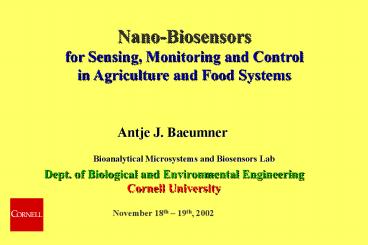Bioanalytical Microsystems and Biosensors Lab - PowerPoint PPT Presentation
1 / 16
Title:
Bioanalytical Microsystems and Biosensors Lab
Description:
Bioanalytical Microsystems and Biosensors ... Identify specific objectives of a national research program ... Avoiding the spoilage of large quantities of milk ... – PowerPoint PPT presentation
Number of Views:519
Avg rating:3.0/5.0
Title: Bioanalytical Microsystems and Biosensors Lab
1
Nano-Biosensors for Sensing, Monitoring and
Control in Agriculture and Food Systems
Antje J. Baeumner Dept. of Biological and
Environmental Engineering Cornell University
Bioanalytical Microsystems and Biosensors Lab
November 18th 19th, 2002
2
Contents of Presentation
Background and rationale Identify specific
objectives of a national research program
Identify potential outcomes and impacts of the
research Estimate research budget
3
Background and Rationale
WHAT?
Biosensor Definition Analytical
device Biorecognition element Physicochemi
cal transducer
Bioanalytical Microstructured
housing Microsystems Microstructured
transducer Micro/Nanostructured interface to
bio-element Integration with sample
preparation steps
Application areas Environment Food
safety Food processing Biosafety and
biosecurity
4
Standard Procedures Microbiological culture
procedures Microscopy Biochemical
assays Immunoassays PCR
Disadvantages Time consuming and/or non-spec
ific and/or cost-intensive
and/or non-portable and/or trained
personnel
Biosensors Fast inexpensive simple to
use portable multi-analyte, high
throughput
Micro/Nanobiosensor Fast inexpensive simpl
e to use portable multi-analyte, high
throughput
5
Detection and quantification of DNA or RNA
Standard Procedure (Southern, Northern
Blot) Detection limit fmol Analysis time 48
hours Lab procedure
Simple, optical biosensors based on capillary
action in a membrane strip
Detection limit fmol Analysis time 15
min Portable procedure
6
Background and Rationale
Sophisticated Microfluidic Biosensor
Detection limit amol Analysis time 10
min Portable procedure
7
Nanobiosensors
Novel materials Novel characteristics Novel
functionality Biomimetic structures Data
transmission
Result Better sensitivity
Higher specificity New specificity
Higher reliability Faster results
More complex data interpretation feasible
New application areas implanted
sensors sensor dust continuous
monitoring remote location
8
Integration
Connection to macroworld (read-out, handling)
Analysis of appreciable volumes (mL 100L)
Required Understanding of fundamentals of
biorecognition signal
transduction
Integration with current macro-technologies
9
Objectives of a National Research Program
The essence of nanotechnology is the ability to
work at the atomic, molecular and
macromolecular levels in order to create
materials, devices and systems with
fundamentally new properties and functions. (NNI)
USDA Focus Areas of Interest for
Nanobiosensors Food Systems (Agriculture and
Bioprocessing) Food Safety Natural Resources
Environment
10
Objectives of a National Research
ProgramExample Food Safety
National Integrated Food Safety Initiative
Priorities Qualitative and Quantitative Risk
Assessment Control Measures for Food-borne
Microbial Pathogens Sources and Incidence of
Microbial Pathogens Antibiotic Resistant
Microbial Pathogens Improving the Safety of
Fresh Fruits and Vegetables National
Coordination of Integrated Food Safety Programs
and Resources Food Handler Education and
Training for Consumers and Youth Food Handler
Education for High-risk and Hard-to-reach
Audiences Food Handler Education for Commercial
and Non-commercial Audiences HACCP Model
Development, Testing and Implementation Home
Food Processing and Preservation Integrating
Food Safety into Related Agricultural Programs
11
Objectives of a National Research
ProgramExample Food Safety
Nanobiosensors in Food Safety (pathogen analysis)
Goal Approach
Specific, sensitive analysis of food for all
potential pathogens
Rapid (minutes), inexpensive, simple, quantitative
Continuous and discrete
Fundamentals of pathogen presence in food (NRI)
Novel nanomaterials adaptable to food
analysis (limited sample preparation)
etc.
Novel detection mechanisms based on the
nanoscale (fundamental studies)
Novel integration mechanisms of transducer and
bio-element
Novel integration mechanisms of transducer and
bio-element
Integration of NEMS remote receive/transmit
systems embedded on the chip
12
Objectives of a National Research
ProgramExample Novel integration mechanisms
Research under investigation at the
Nanobiotechnology Center, Cornell University PI
Barbara Baird, Stephen Sass, Ulrich Wiesner
Goal Improve the binding yield and efficiency
of antibodies to their analyte in a
competitive biosensor assay for bacterial
toxins
Approach Patterning surfaces to perfectly match
the molecular binding pattern of antibodies
13
Outcome and Impact of Research
USDA Focus Areas Food Systems (Agriculture and
Bioprocessing) Food Safety Natural Resources
Environment
Continuous monitoring of food safety at critical
control points in food processing
Rapid quality control at critical control points
in food processing
Biosensor application in agricultural settings
(e.g. in automated milking systems
soil/pesticide analysis manure analysis)
Biosensor application in agricultural settings
(e.g. in automated milking system
soil/pesticide analysis manure analysis)
Sensor integration with storage systems,
implanted in cattle etc. for monitoring
14
Outcome and Impact of ResearchExample
Nanobiosensors and Milking
Approach Location of an array of
nanobiosensors directly at the inlet of the
milking machine to monitor for the presence
of bacteria in the milk of each cow
Outcome and Impact Direct quality control of
milk Avoiding the spoilage of large
quantities of milk
Requirements Rapid detection (seconds) No
sample pretreatment (since in-line
detection) Continuous monitoring Remote
sensing capability
Obstacles Not possible with current
technology (array seconds no
pretreatment)
15
Estimate of Research Budget
Suggested 5 topic areas for Nanobiosensors
3 Projects per year in each area 200,000 per
year per project
Annual budget for nanobiosensor research from the
USDA is proposed at 3 million
16
Thank You































